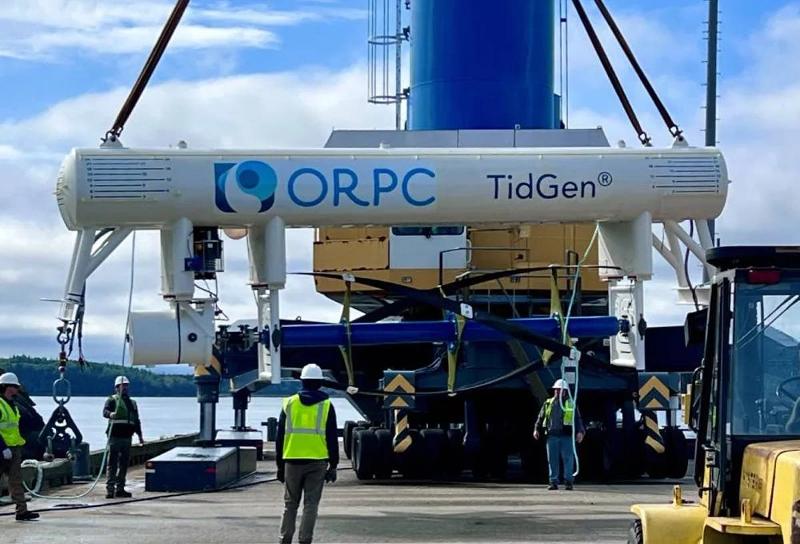The tidal energy industry has been gaining momentum in recent years, offering a sustainable solution for clean electricity generation. With the potential to harness the natural power of tides, tidal energy has the ability to replace diesel generators and contribute to global economic decarbonization. In this article, we will explore the advancements in hydrokinetic turbines and their role in the growth of tidal energy. Join us as we dive into the rising tide of tidal energy and its promising potential for a greener future.
The Potential of Tidal Energy
Explore the vast potential of tidal energy as a renewable and sustainable source of electricity.
Tidal energy has emerged as a promising solution for clean electricity generation. With an estimated 1 terawatt of technically recoverable energy from tidal sources, the potential for harnessing the power of tides is immense.
Unlike traditional energy sources, tidal energy is predictable, reliable, and infinite. It offers a renewable and sustainable alternative to fossil fuels, reducing greenhouse gas emissions and mitigating climate change.
By tapping into the natural motion of the tides, we can unlock a vast source of clean energy that can power communities and industries without harming the environment.
Advancements in Hydrokinetic Turbines
Discover the latest advancements in hydrokinetic turbines and their role in harnessing tidal energy.
Hydrokinetic turbines play a crucial role in converting the kinetic energy of moving water into electricity. These turbines can be deployed in various settings, including rivers, oceans, and existing infrastructure.
Recent advancements in hydrokinetic turbine technology have focused on improving efficiency, durability, and cost-effectiveness. Leading global engineering firms are partnering with tidal energy startups to tackle challenges such as saltwater corrosion and supply chain issues.
By leveraging the ambient flow of water, hydrokinetic turbines offer a sustainable and low-impact solution for harnessing tidal energy. These turbines can be integrated into turnkey microgrid systems, delivering clean electricity to communities around the world.
The Growing Impact on Global Decarbonization
Learn how tidal energy can contribute to global economic decarbonization and the transition to a greener future.
Replacing diesel generators with tidal energy is just one aspect of the industry's potential impact. Tidal energy has the capacity to make a significant contribution to global economic decarbonization, reducing reliance on fossil fuels and mitigating climate change.
By harnessing the power of tides, we can reduce greenhouse gas emissions, improve air quality, and create a more sustainable energy system. Tidal energy can play a crucial role in achieving carbon neutrality and transitioning to a greener future.
As the industry continues to grow and innovate, the positive impact of tidal energy on global decarbonization efforts will become even more pronounced.
Partnerships and Collaborations
Explore the partnerships and collaborations driving the growth of the tidal energy industry.
The tidal energy industry has seen a surge in partnerships and collaborations between industry leaders, startups, and research institutions. These collaborations aim to address challenges such as cost, supply chain issues, and visibility.
Leading global electrical systems firm Schneider has partnered with tidal energy companies to deploy hydrokinetic turbines in turnkey microgrid systems. These partnerships enable the delivery of clean and reliable electricity to communities worldwide.
Additionally, shared knowledge systems, increased visibility in the investor community, and new public policy and market supports are driving the growth of the tidal energy industry.
Conclusion
Tidal energy holds immense potential as a renewable and sustainable source of electricity. With advancements in hydrokinetic turbines and growing partnerships in the industry, we are witnessing a rising tide of tidal energy that can contribute to global decarbonization efforts.
By harnessing the power of tides, we can reduce reliance on fossil fuels, mitigate climate change, and create a greener future. The predictable and infinite motion of the tides offers a reliable and clean energy solution that can power communities and industries without harming the environment.
FQA
How does tidal energy compare to other renewable energy sources?
Tidal energy has several advantages over other renewable energy sources. Unlike solar and wind energy, tidal energy is predictable and reliable, as tides occur twice a day. Additionally, tidal energy has a higher energy density compared to wind and solar, making it a more efficient source of electricity.
What are the environmental benefits of tidal energy?
Tidal energy offers several environmental benefits. It is a clean and renewable source of electricity that produces zero greenhouse gas emissions. Tidal energy projects have minimal impact on marine ecosystems, as they do not require large-scale infrastructure or impoundment of water. Additionally, tidal energy can help reduce air pollution and dependence on fossil fuels.
Are there any challenges associated with tidal energy?
While tidal energy shows great promise, there are some challenges that need to be addressed. These include high upfront costs, limited suitable locations for tidal energy projects, and potential impacts on marine life. However, ongoing advancements in technology and increased collaboration within the industry are helping to overcome these challenges.

